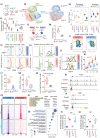This is a preprint.
Microbiota-derived inosine programs protective CD8+ T cell responses against influenza in newborns
- PMID: 38645130
- PMCID: PMC11030415
- DOI: 10.1101/2024.04.09.588427
Microbiota-derived inosine programs protective CD8+ T cell responses against influenza in newborns
Update in
-
Microbiota-derived inosine programs protective CD8+ T cell responses against influenza in newborns.Cell. 2025 Aug 7;188(16):4239-4256.e19. doi: 10.1016/j.cell.2025.05.013. Epub 2025 Jun 9. Cell. 2025. PMID: 40494345
Abstract
The immunological defects causing susceptibility to severe viral respiratory infections due to early-life dysbiosis remain ill-defined. Here, we show that influenza virus susceptibility in dysbiotic infant mice is caused by CD8+ T cell hyporesponsiveness and diminished persistence as tissue-resident memory cells. We describe a previously unknown role for nuclear factor interleukin 3 (NFIL3) in repression of memory differentiation of CD8+ T cells in dysbiotic mice involving epigenetic regulation of T cell factor 1 (TCF 1) expression. Pulmonary CD8+ T cells from dysbiotic human infants share these transcriptional signatures and functional phenotypes. Mechanistically, intestinal inosine was reduced in dysbiotic human infants and newborn mice, and inosine replacement reversed epigenetic dysregulation of Tcf7 and increased memory differentiation and responsiveness of pulmonary CD8+ T cells. Our data unveils new developmental layers controlling immune cell activation and identifies microbial metabolites that may be used therapeutically in the future to protect at-risk newborns.
Conflict of interest statement
Declaration of Interest: The authors declare no competing interests.
Figures





References
Publication types
Grants and funding
- U01 HL148861/HL/NHLBI NIH HHS/United States
- F30 HL165594/HL/NHLBI NIH HHS/United States
- R01 HL156860/HL/NHLBI NIH HHS/United States
- P30 DK078392/DK/NIDDK NIH HHS/United States
- K12 HD028827/HD/NICHD NIH HHS/United States
- P30 DK090971/DK/NIDDK NIH HHS/United States
- P30 AR047363/AR/NIAMS NIH HHS/United States
- R01 HL166245/HL/NHLBI NIH HHS/United States
- R01 DK116868/DK/NIDDK NIH HHS/United States
- R01 DK114123/DK/NIDDK NIH HHS/United States
- P30 ES001247/ES/NIEHS NIH HHS/United States
- R01 HL155934/HL/NHLBI NIH HHS/United States
- R01 AI172960/AI/NIAID NIH HHS/United States
- K08 HD084686/HD/NICHD NIH HHS/United States
- R01 HL155611/HL/NHLBI NIH HHS/United States
- R01 AI145840/AI/NIAID NIH HHS/United States
- R01 AI175431/AI/NIAID NIH HHS/United States
LinkOut - more resources
Full Text Sources
Research Materials
